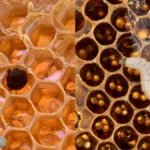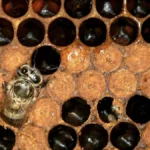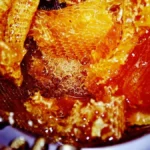What does capped brood look like? We have a look at the difference between capped brood and capped honey. It is important to be able to identify the differences between brood and honey cells in your beehive.
When I was a student I used to perform bee removals for pocket money. A talkative chap once walked up to me and grabbed a brood comb from the bucket of combs I had removed. Then to my horror, he took a bite. I still laugh as I remember him bravely chewing up the white mushy bee larvae and bee silk in the brood comb.
When he was finished, his face had a funny expression. He told me that the honey was salty and he did not like it and walked away. I laughed until I nearly fell over. It is really important to be able to identify honeycomb and differentiate it from bee brood!!
What Does Honeycomb Look Like?
Honeycomb consists of two types – uncapped and capped honeycomb.
Uncapped Honey Comb
If you look into the uncapped comb, you will see nectar in the cell. This is the nectar that is being treated by enzymes and is being dried by the bees. If you see an egg or larvae in there, then you are not looking at nectar.
Uncapped honey is delicious. As a beekeeper, you can take a few frames of uncapped comb and shake these over a plat. If the nectar is fresh, it will spill onto the plate and then you can go full caveman later and lick this treat of the plate. There are few things more flowery, magical, and sweet than fresh nectar from a hive on a warm summer’s day.
The bees will fill the cells with nectar and process this until the cell is full, and the nectar has been dried to a point of containing 80-83% sugars.
Capped Honey Comb
Once the cell is full and the nectar is 80-83% sugar it is called honey. At this point, the bees will cover the ripe honey with a wax cap to prevent moisture from going back into the honey.
Capped honey is quite easy to see – it was a layer of wax over it. The cappings will sometimes have a little air bubble behind them. In this case, the honeycomb has a white look. If there is no air bubble, the honey will be right up against the wax cap, and this will look darker.
It is important to understand this look of wax on honey to understand the difference between brood and honey cells.

What Does Capped Brood Look Like?
In differentiating between capped brood versus capped honey we start with the fact that honey is capped with wax.
The queen lays eggs and these become larvae. Capped bee brood has bee pupae underneath. Bee pupae require oxygen, hence brood cappings are oxygen permeable. When a bee pupates it has a little layer of bee silk around it. The capping is an oxygen permeable capping that is slightly raised.
Generally, bee brood cappings have a more orange to red color than wax cappings. Bee brood cappings have a leathery feeling to them, whereas beeswax has a waxy oily feel to it.
Bee brood is much less heavy than honeycombs. When you remove a frame of brood it will weigh 50% less than a honeycomb.

An Easy Way For Beginners To Tell The Difference Between Brood and Honey Cells
If you take a capped comb out, have a close look at it:
Are there any open cells in the comb – have a look in the cells – if there are eggs or larvae, chances are the rest of the frame is brood.
If there is nectar in the cells, this does not mean that the frame is honey, however.
Take a match – open a few cells in the middle of the frame – if there is a little white pupa or a grey bee in there the frame is brood.
If it is honey in there, and the frame is heavy, then you have a honey frame. Now go and scratch around in the hive and find a frame of brood – feel the difference between the two. Soon you will be an expert at it.
What To Do If You Accidentally Bring Brood Home?
You followed my instructions and something went wrong. Somehow you have a few frames of brood at home.
Do not put the brood back in a hive – the chances are that the brood has become chilled. Bees require a constant temperature when they are developing. If brood is cooled below their optimum temperature, the bees will come out deformed, or die and rot in the cells. This is called chill brood.
There Are A Few Interesting Things You Can Do With The Brood:
Feed it to your chickens – the chickens will peck the combs clean of brood and if you watch them carefully, to till be able to salvage the combs before they eat the wax too. Bee brood is an excellent source of protein and lipids and your chicken eggs will be amazing.
If the brood is in relatively fresh comb – you can tell this if the combs are yellow, not brown – you can just take the whole brood comb and fry it with butter and garlic. The bee larvae taste a lot like small shrimp and are full of health benefits.
You can take the comb and squeeze the liquid from it. This white brood homegenate can be added to smoothies, or you can place it in a tray and dry it in your freezer. Put the dried homegenate in capsules and take it as a supplement.
Why Eat Brood?
All cultures have their things that are considered “ok and normal” and things that are “disgusting”. Bee brood is a common food in much of the world. In central Africa brood is hailed as a source of virility and strength, giving both men and women a bit of “lion”mprowess in the evenings. In China, drone brood extract is known as Chinese viagra for a similar reason.
Bee brood also tastes surprisingly good. I still find it has a “weird” factor, but once you overcome that, it actually tastes really good. The trick is lots of garlic and chives.
We hope this helped you answer the question “What does capped brood look like?” and if so, please share this with friends. Maybe even invite them to a bee brood stirfry evening. You never know, you may all have big smiles on your faces the next day as the old African truths sink home.
Read more about: Beehive Frames Without Foundation

Dr. Garth A. Cambray is a Canadian/South African entrepreneur and beekeeper with 28 years of experience in apiculture and specializes in adding value to honey. His Ph.D. research developed a new advanced continuous fermentation method for making mead that has resulted in a number of companies globally being able to access markets for mead. His company, Makana Meadery, exports honey mead to the USA where it is available to discerning connoisseurs. He has also developed technologies to commercially manufacture organic honey vinegar in Zambia for export globally. He holds a few patents globally in the ethanol industry and believes in technology and knowledge transfer for human development and environmental sustainability. One of his proudest achievements is the fact that the wind farm he started at one of his old apiary sites has essentially made his hometown carbon neutral.






